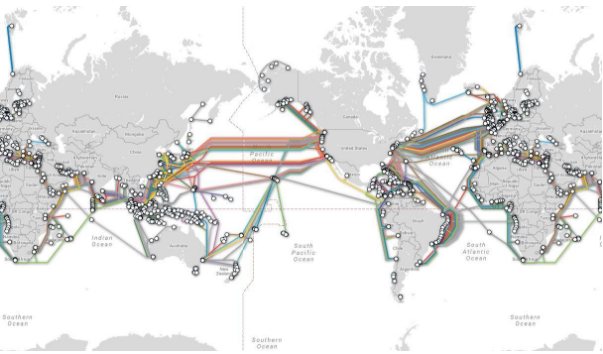This map shows how undersea cables move internet traffic around the world

New map shows how undersea cables connect the world. Image: REUTERS/Anindito Mukherjee

Get involved with our crowdsourced digital platform to deliver impact at scale
Stay up to date:
Digital Communications
Have you ever wondered how internet traffic flies around the world? 99% of it travels through cables under the sea. That’s your internet telephone conversation, your instant messages, your email and your website visits, all making their way beneath the world’s oceans.
The reason is simple: in recent years, data has travelled through fibre optic cables. These are much faster and cheaper than trying to bounce messages off satellites and through the airwaves. But we can’t lay them all across our increasingly congested ground, nor can we realistically build telegraph cables to stretch over the Atlantic Ocean.
The miles and miles of cables, which are roughly the size of a garden hose, carry internet traffic at the speed of light. They can carry so much traffic that fewer than 300 cable systems transport almost all internet traffic around the world.
Where are the cables?
This fascinating, interactive map shows the history behind each cable, and shows all the connections between countries. You can have a browse here.

Some notable examples include what is currently the world’s highest-capacity undersea internet cable: a 5600-mile link between the US and Japan. Aptly named “FASTER”, the cable connects Oregon in the USA with Japan and Taiwan. It’s owned by Google and a consortium of other communications companies. “FASTER is one of just a few hundred submarine cables connecting various parts of the world, which collectively form an important backbone that helps run the Internet,” said Urs Hölze, a Google Executive.

This map shows the cables in one glance.

The amount of internet traffic
The demand for internet capacity is only going to increase. In the future there will be millions of devices connected to the internet, known as the Internet of Things. Cisco estimates that consumer internet traffic will increase by 26% by 2020.
How do you lay the cables in the first place?
This photograph shows how Google laid its FASTER cable. Installing the cable under the sea requires specially designed ships which can lay anywhere from 100-150km of cable per day. The fibre optic cables are very fragile, so they are surrounded with layers of tubing and steel to prevent damage.

A number of things can damage cables. This shark was filmed attempting to take a bite out of the cable. It’s thought it was attracted to the electromagnetic pulses given off by the cable, as sharks also find prey that way.
There are also more ordinary threats to cables, such as construction projects that damage the cables by accident, or even anchors dropped from boats.
Some worry about more sinister attacks. “Russian submarines and spy ships are aggressively operating near the vital undersea cables that carry almost all global internet communications, raising concerns among some American military and intelligence officials that the Russians might be planning to attack those lines in times of tension or conflict,” explained a recent New York Times piece.
If a cable gets damaged, divers are dispatched to take a look at the damage. The cable is then brought to the surface and fixed.
Don't miss any update on this topic
Create a free account and access your personalized content collection with our latest publications and analyses.
License and Republishing
World Economic Forum articles may be republished in accordance with the Creative Commons Attribution-NonCommercial-NoDerivatives 4.0 International Public License, and in accordance with our Terms of Use.
The views expressed in this article are those of the author alone and not the World Economic Forum.
The Agenda Weekly
A weekly update of the most important issues driving the global agenda
You can unsubscribe at any time using the link in our emails. For more details, review our privacy policy.
More on Nature and BiodiversitySee all
Lisa Donahue and Vance Scott
April 28, 2024
Dan Lambe
April 24, 2024
Roman Vakulchuk
April 24, 2024
Charlotte Kaiser
April 23, 2024
Jennifer Holmgren
April 23, 2024
Agustin Rosello, Anali Bustos, Fernando Morales de Rueda, Jennifer Hong and Paula Sarigumba
April 23, 2024






